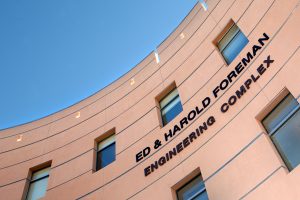NMSU engineering professors rank among top 2% in their research fields worldwide

Engineering professors from New Mexico State University have earned the distinction of being among the top 2% of scientists worldwide as measured by the impact of their research publications. The engineering authors were identified in a worldwide database of top scientists created by Stanford University and recently published in the journal Public Library of Science Biology.
“Our faculty are at the forefront of several key research areas in engineering. They are among the best of our peers in terms of research productivity. The number of publications per faculty and number of citations, place our researchers very competitively among our peers,” said Lakshmi N. Reddi, dean of the College of Engineering.
John P.A. Ioannidis, professor at Stanford University, led the creation of the database which ranks the most cited authors across all scientific disciplines. The publicly available database classifies the publications in 22 scientific fields with 176 subfields.
The study lists the top 100,000 scientists in all fields. The data also include scientists who are not in the top 100,000 of all research disciplines, but are within the top 2% of scientists of their main subfield discipline, assessing career-long citation impact up until the end of 2019 and for citation impact during the single calendar year 2019.
Earning a place among the world’s top 2% scientists ranked in their specific research subfields over their entire career as well as for the year 2019 are the following NMSU engineering professors:
Associate Professor Abdessattar Abdelkefi, Department of Mechanical and Aerospace Engineering: aerospace and aeronautics
Abdelkefi was a top grant awardee in the mechanical engineering department for the past fiscal year, garnering $634,482 through 11 multidisciplinary projects. He leads the Nonlinear Dynamics and Energy Harvesting Laboratory conducting research on multidisciplinary projects such as environmental testing, nonlinear dynamics, uncertainty quantification, and characterization of dynamical systems including pipeline conveying fluids, energy harvesters, wind turbines, drones and nano-systems.
Professor Igor Sevostianov, Department of Mechanical and Aerospace Engineering: mechanical engineering and transports
Sevostianov’s research interests are in the quantitative characterization of microstructures of non-homogeneous materials, microstructure-properties relationships, and connections between different physical properties. His research has important implications in additive manufacturing, radiation damage control, development of new materials for bone implants, etc.
Sevostianov is currently director of NMSU Research Initiative for Scientific Enhancement to the Post-doctorate Program funded by the National Institutes of Health for $3.3 million (2018-2022). He is also principal investigator on four grants funded by NASA, National Science Foundation and the U.S. Department of Agriculture with a total amount of more than $1.5 million of extramural funding and co-principal investigator in several other projects.
Professor Jaime Ramirez-Angulo, Department of Electrical and Computer Engineering: electrical and electronic engineering
Ramirez-Angulo works in the design and testing of analog and mixed-signal very large-scale integration microelectronic systems. He is an Institute of Electrical and Electronics Engineers Life Fellow and Outstanding Achievement Professor. He was recipient of the Westhafer and University Research Council Awards at NMSU and has published 600 papers in his specialty area.
Professor Nagamany Nirmalakhandan, Department of Civil Engineering: biotechnology
Nirmalakhandan was co-principal investigator of a multi-disciplinary team leading the National Science Foundation Engineering Research Center for Re-inventing America’s Urban Water Infrastructure. Beginning in 2011, NSF funded $36.7 million in the center over 10 years. Nirmalakhandan continues to receive funding under ReNUWIt and associated projects.
Mechanical and Aerospace Engineering Department Head Jay I. Frankel: mechanical engineering and transports
Other engineering professors who ranked among the top 2% for citations in their specific subfields during the year 2019 follow:
Professor Pei Xu, Department of Civil Engineering: environmental engineering
Xu’s research focuses on developing innovative technologies for sustainable water reuse and desalination funded by the National Science Foundation, U.S. Department of Energy, U.S. Bureau of Reclamation, water utilities and industry. She was awarded $950,612 in funding for her water research during the past fiscal year. She is the research director of the New Mexico Produced Water Research Consortium and leads NMSU’s efforts on the National Alliance for Water Innovation team that received a U.S. Department of Energy five-year, $100 million grant to create the Energy-Water Desalination Hub.
Associate Professor Tom Manz, Department of Chemical and Materials Engineering: organic chemistry
Manz received a National Science Foundation Career Award in 2016. He leads a group focused on the creation of new computational methods to expand modeling capabilities of physical and chemical interactions that could be used in a variety of applications.
Professor Zohrab Samani, Department of Civil Engineering: environmental engineering
Samani has more than 40 years of experience in teaching and research on remote sensing, water management, irrigation systems design, groundwater hydrology and international technology transfer. He has worked in 18 different countries by showing water management technologies. Samani received the American Society of Civil Engineers best paper award in 2019. Samani has received two patents on renewable energy and liquid organic fertilizer. Samani is currently working on an organic anti-icer for transportation application, through a National Science Foundation-funded project.
Professor David Voelz, Department of Electrical and Computer Engineering: optoelectronics and photonics
Voelz performs research on optical imaging, spectral and polarimetric sensing, laser beam propagation, atmospheric turbulence and free space communications. He has published extensively on numerical physical (wave) optics methods for modeling the propagation of light and image formation through turbulence. Other contributions include experimental work on optical sensing technologies and astronomical instrumentation.
The Stanford University study published in the journal Public Library of Science Biology can be found at https://journals.plos.org/plosbiology/article?id=10.1371/journal.pbio.3000918.
